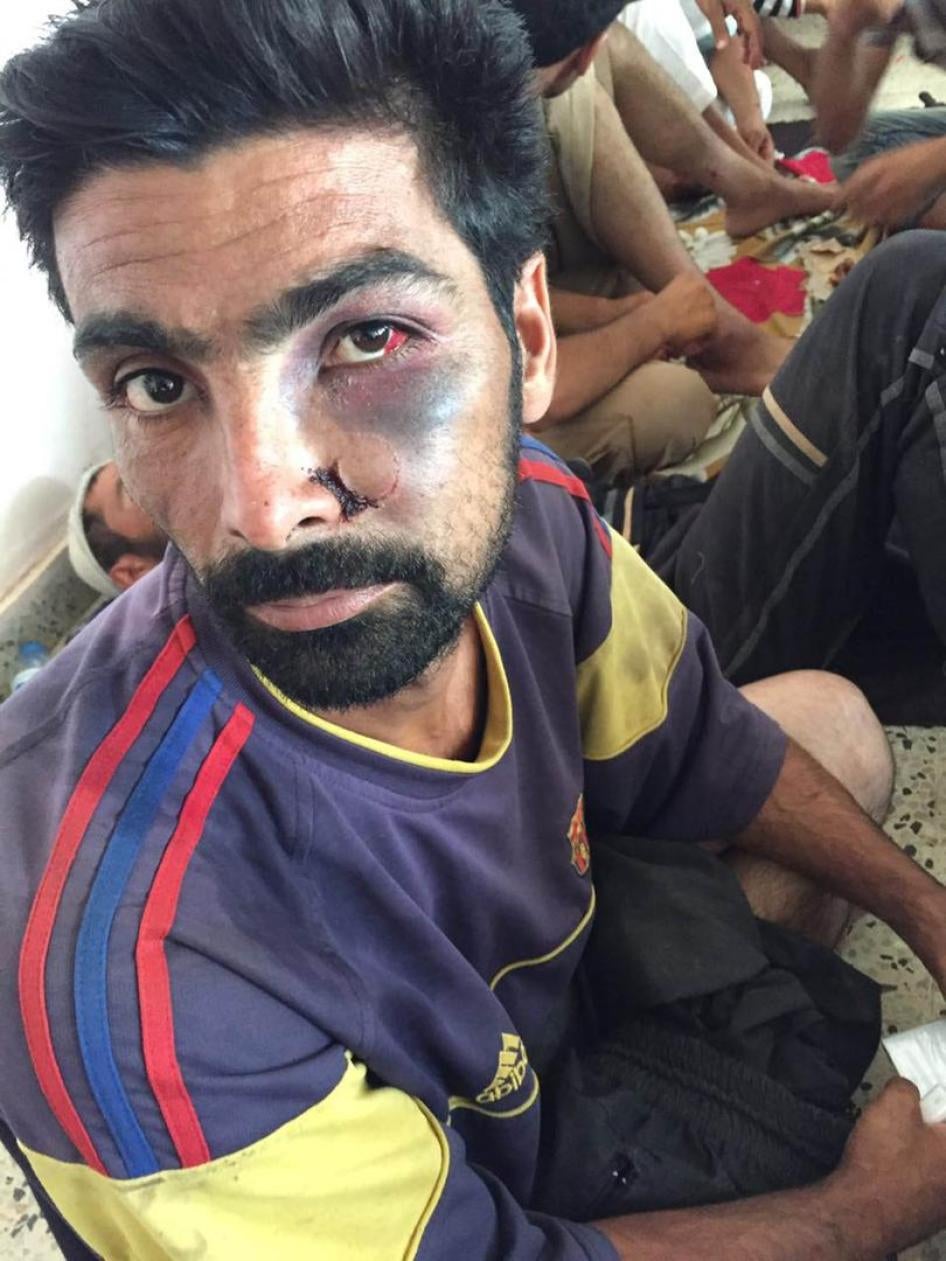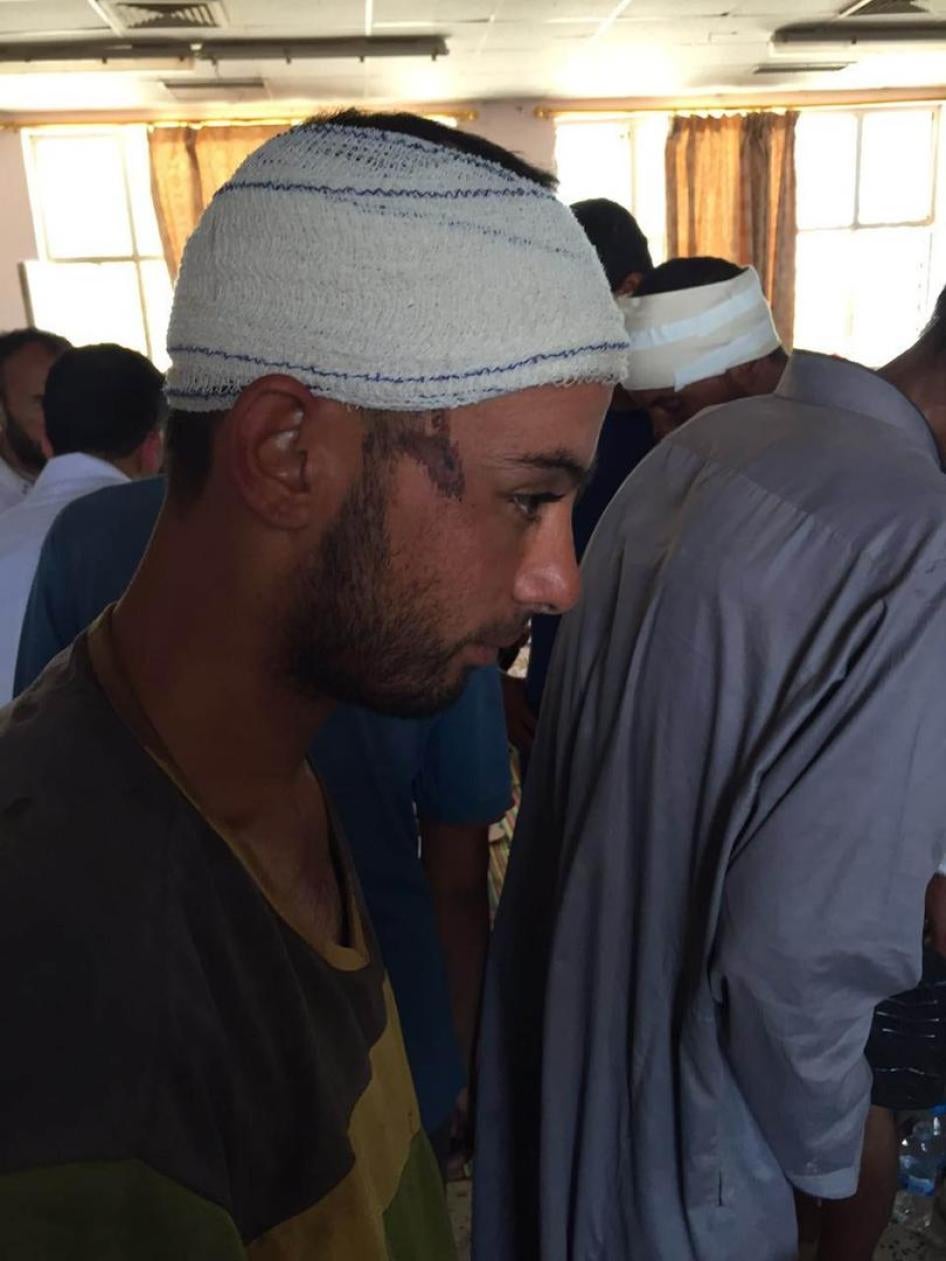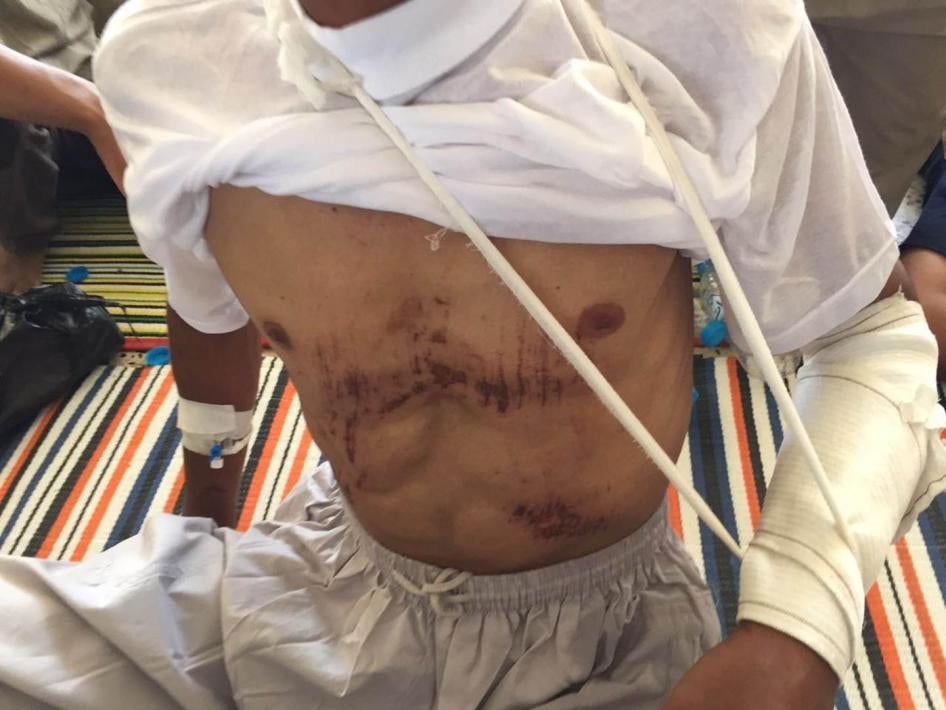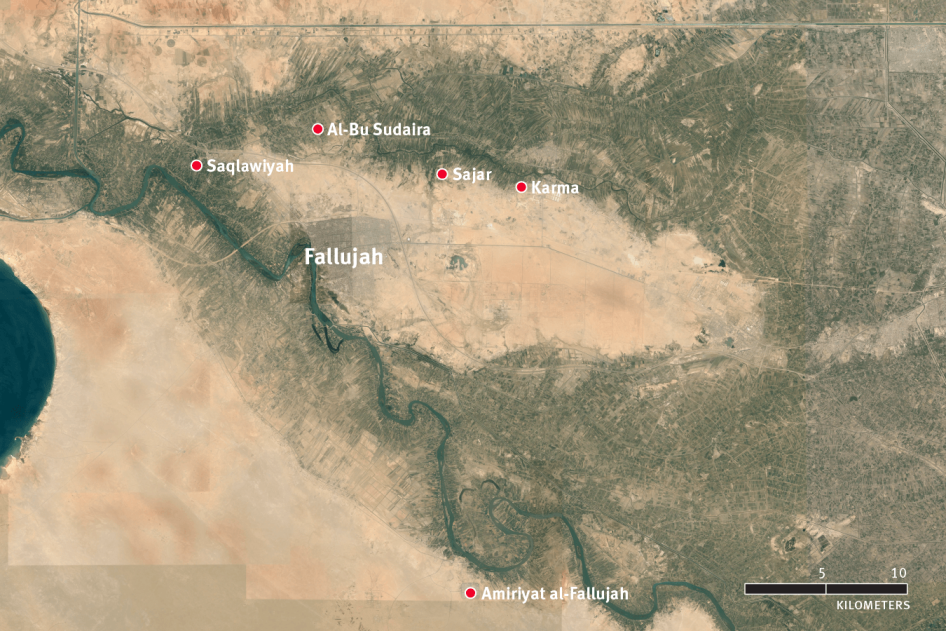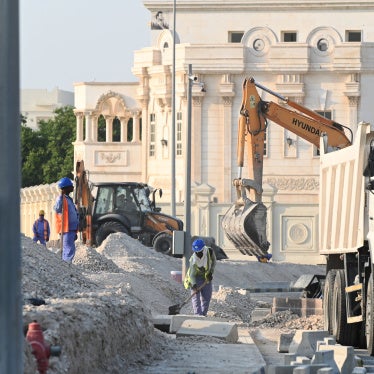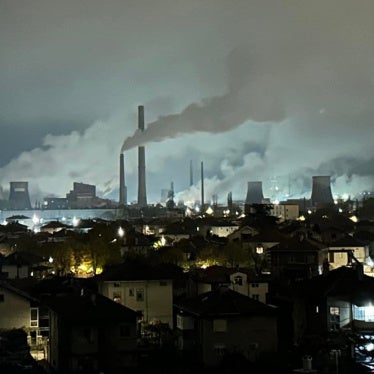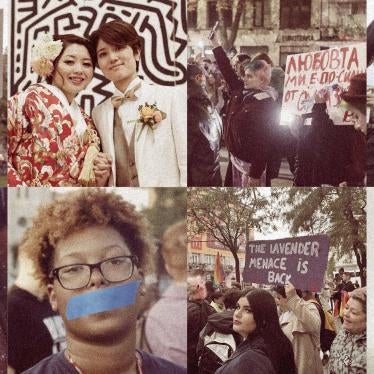(Beirut) – The announced investigation into allegations of abuse of civilians around Fallujah by Iraqi government forces is a test for the government’s ability to hold abusive forces accountable. Judicial officials should conduct this investigation transparently and impartially, assess command responsibility, and ensure protection for victims and witnesses.
Ahead of the offensive in Fallujah against forces of the Islamic State (also known as ISIS), Prime Minister Haider al-Abadi said that his government had taken measures to protect civilians. Human Rights Watch, however, has received credible allegations of summary executions, beatings of unarmed men, enforced disappearances, and mutilation of corpses by government forces over the two weeks of fighting, mostly on the outskirts of the city, since May 23. On June 4, 2016, in response to allegations of abuse, al-Abadi launched an investigation into abuses in Fallujah and issued orders to arrest those responsible for “transgressions” against civilians. On June 7, al-Abadi announced the “detention and transfer of those accused of committing violations to the judiciary to receive their punishment according to the law.”
“The Iraqi government needs to control and hold accountable its own forces if it hopes to claim the moral upper hand in its fight against ISIS,” said Joe Stork, deputy Middle East director. “It’s high time for Iraqi authorities to unravel the web of culpability underlying the government forces’ repeated outrages against civilians.”
Human Rights Watch also expressed grave concern about reports of ISIS preventing civilians from fleeing Fallujah and allegedly executing and shooting at those who attempted to do so. Human Rights Watch is concerned about the presence of ISIS fighters among civilians inside Fallujah, perhaps amounting to human shielding, a war crime. But the presence of fighters among civilians does not absolve forces fighting ISIS from the obligation to target only military objectives and to take all feasible measures to avoid civilian harm, Human Rights Watch said. ISIS forces should allow civilians to leave areas under their control and not use civilians to shield its military objectives from attack, Human Rights Watch said.
Human Rights Watch directed questions about the composition of the investigative committee, its authority, and relation to the judiciary to five Iraqi government institutions in addition to the human rights section of the United Nations Assistance Mission to Iraq. A member of the parliamentary Human Rights Committee told Human Rights Watch that the committee had started its own investigation and was liaising with the investigation by the prime minister’s office, which remained secret. The other officials contacted did not respond to multiple requests for comment.
On June 3, Human Rights Watch received information alleging that members of the Federal Police and the Popular Mobilization Forces (PMF), an auxiliary fighting force created after ISIS advanced in June 2014, and that includes many pre-existing Shia militias, had executed more than a dozen civilians from the Jumaila tribe fleeing Sajar, a village north of Fallujah. Human Rights Watch spoke to five people, including two officials from Anbar governorate, who said they were protecting three surviving witnesses to the executions.
Three of those interviewed confirmed the account that a survivor gave on Tigris (Dijla) Channel television that a group consisting of Federal Police and PMF had separated men from women, marched the men to where the troops’ officers were, lined them up, and shot at least 17 of them, including one teenage boy. One person said that the incident took place on June 2. The PMF are, at least nominally, under the command of the prime minister.
One of the Anbar governorate officials provided Human Rights Watch with a list of names of those killed and said that the incident happened near the Sharhabil school in Al-Bu Sudaira neighborhood in the northern outskirts of Fallujah. The other Anbar official said that the witnesses met with senior Iraqi government officials on June 5, following which he said Prime Minister al-Abadi launched an investigation into the incident. A former Iraqi government official with good contacts in the security forces told Human Rights Watch, on June 5, that the investigation had already led to the arrest of a police officer whom survivors could name.
Another person who said he was in the Sajar area, 7 kilometers northeast of Fallujah, at the time told Human Rights Watch that on May 28, he saw Federal Police and PMF, including dozens of fighters from the Badr Brigades and Hezbollah (two prominent Shia militias in the PMF), fatally shoot civilians with white flags raised fleeing toward the government forces that day. He said that a fighter told him his superior officer had ordered the shootings. He also told Human Rights Watch he was in Saqlawiya around May 30. This person said a villager and several PMF fighters in the area told him that PMF fighters stabbed dozens of villagers to death with knives.
On June 6, an Anbar governorate official who provided the names for those killed from the Jumaila tribe was visiting a camp for internally displaced people in Amiriyat Fallujah, a town south of Fallujah itself, when he spoke to Human Rights Watch. More than 600 men whom Hezbollah and the Badr Brigades, among other PMFs, had released from detention the day before had just arrived in Amiriyat Fallujah Hospital, he said. He added that the militias had detained the men, most from the al-Mahamda tribe, since the beginning of the operation in homes and other buildings in the Hayy al-Shuhada area in Saqlawiya, only releasing them on June 5. He said that he saw hundreds of people among the former detainees who showed signs of torture, including rape, burns, knife cuts, and bruising from beatings. He said the men who were released told him that they saw the PMF fighters take away another at least 600 al-Mahamda men.
A Baghdad resident told Human Rights Watch on June 6 that during a visit to Amiriyat Fallujah Hospital on June 5, she saw hundreds of visibly injured men. Five of the men she spoke to said that PMF forces detained them in groups as they recaptured Saqlawiya over the previous or two weeks. The men told her that the PMF had altogether arrested 1,700 men, whom they beat and dragged bound to a moving car by a rope (sahl) before releasing 605 men to receive medical treatment on June 5. The woman said the men told her that four men died from beatings and from being dragged behind cars. She told Human Rights Watch that hospital staff in Amiriyat Fallujah said a fifth man died on June 5 in the hospital. Human Rights Watch reviewed a video of three injured men stepping out of an ambulance at what the person said was Amiriyat Fallujah Hospital, in addition to pictures of half a dozen injured men being treated in the hospital’s garden.
On May 24, Human Rights Watch viewed a video, uploaded on May 23, in which a commander tells a room filled with fighters that Fallujah had been a bastion of terrorism since 2004 and that no civilians or true Muslims were left inside the city. The video bore the logo of Abu al-Fadhl al-Abbas, one of the brigades within the Leagues of the Righteous militia that is part of the PMF. On May 27, Iraqi activists sent Human Rights Watch two videos they said were filmed on the outskirts of Fallujah over the previous days depicting abuses against local residents by government forces: one showed armed men in a mix of civilian and military dress driving two pickup trucks, each dragging a corpse behind them; the second showed armed men surrounding a pile of corpses and severed heads. In the clip a commander counted 16 decapitated bodies and heads. Human Rights Watch was not able to verify the origins of either video. On June 3, Human Rights Watch viewed a widely circulated video on Facebook, uploaded on June 3, which shows a man in a military-type uniform beating at least nine men lying on the ground with a large wooden stick while accusing them of collaborating with ISIS in “Fallujah”. Human Rights Watch was unable to verify the exact location and time of the videos.
A local sheikh from Karma, a town northeast of Fallujah, told Human Rights Watch that within the first few days of the military operation to retake the city, the Iraq Security Forces, PMF, police, and Sunni forces forced civilians living there to leave. During the exodus, at least 70 young men disappeared, he said, and the families have no information as to their whereabouts. The sheikh said that on June 1, the Iraqi Parliament Speaker, Salim al-Jiburi, had come to the area to speak to local elders and the military. A member of Anbar governorate council, who also provided information about the launch of the prime minister’s investigation, confirmed the number of missing men to Human Rights Watch and said that the government had opened investigations to determine where they are.
The military routinely separates men from women and takes the men for security screenings to determine their involvement with ISIS forces, according to all witnesses Human Rights Watch interviewed. The authorities may impose reasonable and proportionate security measures, but should do so under judicial supervision and in a transparent manner, Human Rights Watch said. The families of anyone detained should know where they are being held, and all persons detained should promptly be brought before a judge to determine the legality of their detention.
All suspected crimes, including torture, murder, and other abuses, committed by members of any side in the conflict, should be investigated by the criminal justice authorities, speedily, transparently, and effectively, up to the highest levels responsible. When evidence of criminal responsibility emerges, prosecutions should follow. Those conducting such criminal investigations and making decisions about prosecutions should be independent of those being investigated, including being outside any military chain of command and being free from political interference in their decisions. The authorities should ensure the safety of all witnesses. At the same time, a commission of inquiry or equivalent should be created to examine the wider concerns about whether such crimes and abuses are being committed in a widespread or systematic way.
On June 3, the highest Shia religious authority, Ayatollah al-Sistani “cautioned” that fighters must not attack non-combatants materially or psychologically. On June 5, Hadi al-Amiri, the commander of the Badr Brigades, vowed to hold those responsible for abuse accountable.
“I acknowledge that there were mistakes,” al-Abadi told Iraqi state television on June 4, “but they were not systematic and we will not cover up any [of them].”
“The government should not stand idly by while fighters commit atrocities in its name,” Stork said. “Political, security, and judicial officials should work together transparently to establish the truth about what has happened around Fallujah and why.”
The Fallujah Operation
On May 23, Iraqi security forces began operations to retake Fallujah, where UN officials estimate about 50,000 civilians, including 20,000 children, remain. Those forces include the elite US-trained military Counter-Terrorism Service (CTS), local and federal police, militias under the Popular Mobilization Forces (PMF) umbrella, Sunni fighters from Anbar province, and Iraqi and US-led coalition air forces.
ISIS captured the city in early 2014. Government forces cut off supply routes into the city after recapturing nearby Ramadi in late December 2015 and the al-Jazira desert area north of Fallujah in March 2016. In late March, a medical source in Fallujah told Human Rights Watch that each day starving children were arriving at the local hospital and most foodstuffs were no longer available at any price. In April, Iraqi activists in touch with families inside Fallujah told Human Rights Watch that conditions had reduced families to eating flat bread made with flour from ground date seeds and soups from grass. A man who fled Fallujah in 2014 said in late May that sources in the city told him people who escaped from Fallujah in May 2016 were dropping plastic bags and water bottles filled with medical supplies into the Euphrates upstream for trapped residents to recover from the river as it ran through the city.
Human Rights Watch has not had access to Fallujah, but obtained information on conditions inside the city from relatives, journalists, officials, and humanitarian workers who said they had been in touch with people remaining there.
In recent years Human Rights Watch has documented extensive laws of war violations by the ISIS as well as by Iraqi military and the largely Shia militias that make up the Popular Mobilization Forces, including summary executions, disappearances, torture, use of child soldiers, widespread demolition of buildings, indiscriminate attacks, and unlawful restrictions on the movement of people fleeing the fighting.
Trapped Civilians
On May 22, the Iraqi government called on civilians inside the city, 65 kilometres west of Baghdad, to leave through unspecified secured routes. Fourteen thousand people have managed to escape the areas surrounding the city center and reach displacement camps in the neighboring town of Amiriyat Fallujah.
Since the government offensive began on May 23, there have been regular reports of ISIS executing or shooting at civilians attempting to flee. A foreign correspondent told Human Rights Watch that Shia militiamen holding positions in Saqlawiya, a town northwest of the city, said they witnessed civilians carrying white flags make several failed attempts to escape from areas still under ISIS control. In each instance, ISIS opened fire on the militia positions the civilians were attempting to reach, forcing them to turn back. They said they had not seen ISIS firing directly on the civilians.
In early May, ISIS retook Hassi and Al-Bu Huwa, two villages south of Fallujah, for a few days. An engineer from Al-Bu Huwa who was able to escape to Baghdad said that, on May 10, ISIS ordered residents to evacuate the villages for Fallujah. Members of Al-Bu Isa tribe gathered their fighters together and refused the order, he said. He also said he had heard that two Al-Bu Isa women committed suicide. ISIS responded by executing 25 Al-Bu Isa men. The engineer said he saw the bodies of the executed men as he left the village. He said he escaped from ISIS as he was being transferred to Fallujah.
Intermingling with Civilians
ISIS is also exposing civilians to harm by placing their fighters among them, Human Rights Watch said. A man whose family is still in Fallujah with intermittent access to a phone said they told him that ISIS forced all civilians in the city, including his family, to relocate to the center, among its fighters.
In northern Iraq, on the Makhmur front line, the Iraqi army, Kurdish Peshmerga and volunteer National Mobilization Forces, a group of volunteers within the Popular Mobilization Forces, are battling ISIS near Qayyara. Local residents who escaped Mahana, Kudila, Kharabarut and other villages near there told Human Rights Watch in late May that ISIS forces had fired from in between houses they said were inhabited by civilians at the time, which were then hit by return artillery fire.
Attacks on Civilian Objects
One man with family inside Fallujah showed Human Rights Watch photographs that he said a Fallujah General Hospital staff member sent him after an attack on the hospital at 8 p.m. on May 25. The hospital worker wrote that an airstrike damaged the emergency room and other parts of the facility. He said that ISIS fighters had been occupying the second floor of the hospital for months. The man was unable to confirm the extent of the damage or whether any civilians were wounded or killed in the attack.
A doctor who used to work at Fallujah hospital but left the city in 2015 sent Human Rights Watch footage of damage to the building and interviews with patients who said they had been wounded in the attack, but that it had been Iraqi forces’ shelling rather than an airstrike. He said the emergency room had been able to continue functioning despite the damage.
The hospital staff member said he was unaware of either the Iraqi military or the coalition informing patients and staff of an impending strike, such as through public messages or dropping flyers.
Under the laws of war, applicable to the armed conflict in Iraq, all hospitals and other medical facilities, whether civilian or military, have special protection. They may not be targeted, even if being used to treat enemy fighters. Medical facilities remain protected unless they are used to commit hostile acts that are outside their humanitarian function. Even then, they are only subject to attack after a warning has been given setting a reasonable time limit, and after such warning has gone unheeded. It is a violation for armed forces or groups to occupy medical facilities.
